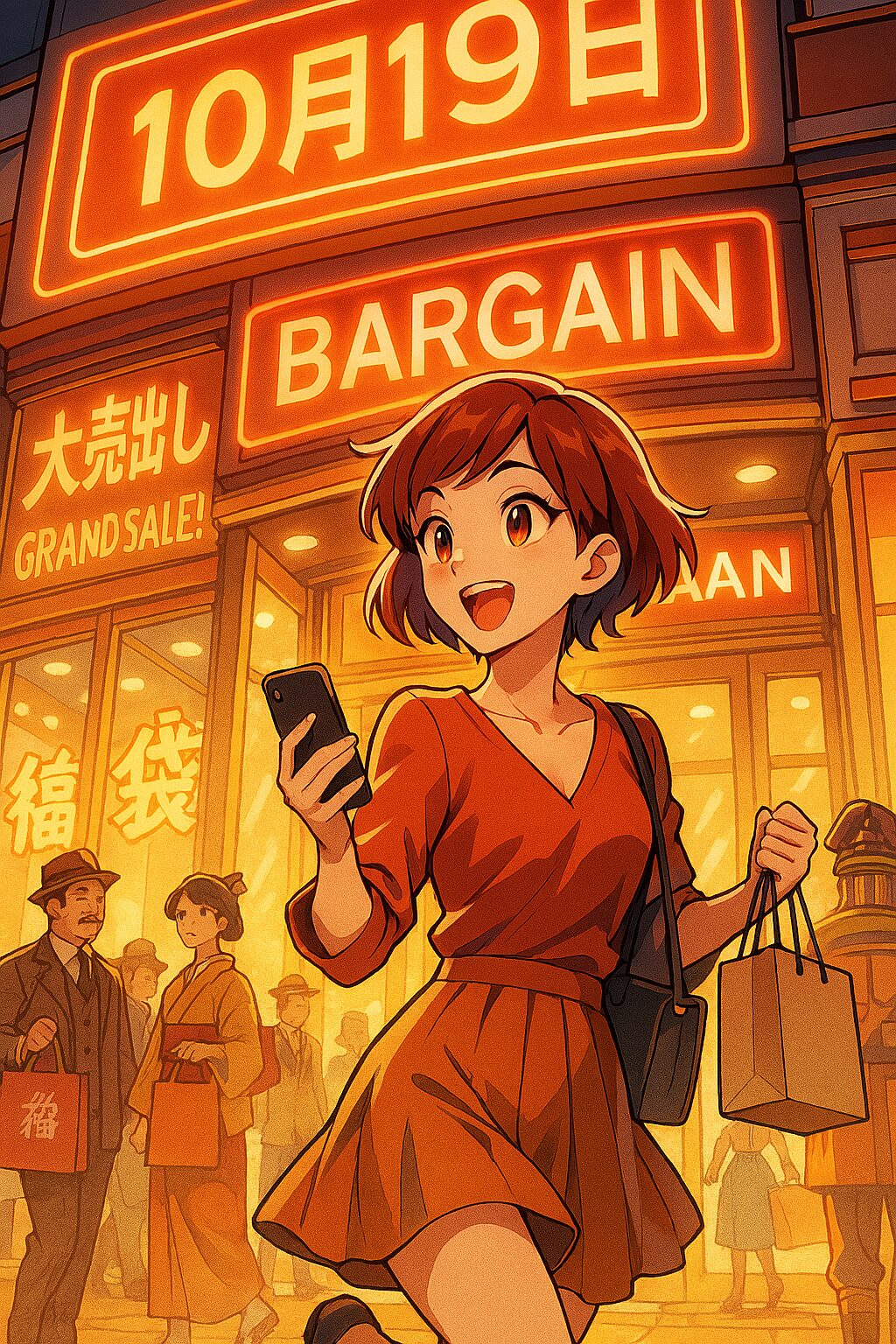Do you know what special day it is in Japan today? While not an official national holiday, October 19th is known as “Bargain Day” (バーゲンの日, Bāgen no Hi), a date of significant importance in Japanese consumer culture. This day goes far beyond just a simple sale, offering a profound key to understanding the history of modern commerce and the cultural background of contemporary Japanese spending habits.
① Keyword: Historical Background and Details of “Bargain Day”
October 19th was designated as “Bargain Day” because on this date in 1895 (Meiji 28), a kimono fabric store in Tokyo held a “Grand Winter Sale,” which is considered the origin of the first full-scale bargain sale in Japan. This large-scale markdown event, conducted by a Gofukuten (kimono fabric store, the precursor to modern department stores), was a groundbreaking shift in the commercial practices of the time.
While discount sales for inventory clearance or cash purchases, such as Tanaoroshi (inventory counting) and Genkin Kakenenashi (cash-only, no credit), existed during the Edo period, their scope was limited. However, with the import of the “Department Store” concept from the West during the Meiji era, Gofukuten began handling a diverse range of products. They started introducing large-scale “sales” aimed at “inventory adjustment” due to seasonal changes and model updates. This “Grand Sale” (大売出し) is precisely the prototype of the modern “Bargain Sale.”
This anniversary symbolizes the modernization of Japanese consumer culture. Previously, transactions in Japan were often based on Kakeuri (credit/post-payment) founded on trust with the merchant, and prices frequently fluctuated through negotiation. The introduction of the bargain, however, helped popularize transparent, Western-style commercial practices, such as “uniform pricing” and “clear discounts from a fixed price.”
Crucially, this “Grand Sale” was enthusiastically welcomed by the common people as an “opportunity to acquire quality goods cheaply.” High-priced items like kimono fabric suddenly became affordable. This offered more than just an economic benefit; it provided a sense of **excitement for a new era and the joy of consumption**.
② Connecting “Bargain Day” to Japanese Culture
“Bargain Day” not only marks the origin of a shopping event but also reflects two distinct facets of Japanese culture.
The first is the fusion of the “Mottainai” spirit and “Rationality.”
The traditional Japanese value of “Mottainai,” which emphasizes not wasting resources, is deeply ingrained. A bargain sale is a highly rational mechanism that finds new value by reducing the price of still-valuable goods instead of discarding them, encouraging consumers to reuse them. This aligns with the “Mottainai” spirit, representing a sustainable economic activity that reduces inventory risk for producers and promotes smart consumption for consumers.
The second is the culture of “Gyōretsu (Queuing)” and “Matsuri (Festival).”
Japanese bargain events, especially the New Year’s “Hatsuuri” (First Sale) and “Fukubukuro” (Lucky Bags) culture, have created a fervent “queuing culture.” People line up in front of department stores and popular brand shops from the early morning. This act goes beyond simply obtaining goods; it transforms into an activity to gain a sense of unity with others sharing the same goal and the exhilaration of participating in a special, annual “festival.” Japanese bargains are not just economic activities; they serve as a seasonal tradition and a commonplace event—a role of **Hare (non-ordinary/festive) time**.
Today, in addition to clothing store “Clearance Sales” and electronics store “Financial Settlement Sales,” foreign bargain cultures like the American-born “Black Friday” and e-commerce “Cyber Monday” are also gaining ground. However, the foundation remains the healthy Japanese desire to “acquire good things smartly,” which began with “Bargain Day” on October 19th, and the ongoing commercial efforts that support it.
③ A Question for Our Readers
Having read this article, we hope you’ve gained insight into the history of Japanese bargain culture, the “Mottainai” spirit embedded within it, and the festive excitement it generates.
If you were to encounter a bargain sale in Japan, how would you approach it? Would you become a “Clever Hunter,” gathering thorough information to find the best possible deal, or would you throw yourself into the enthusiastic “Festive Commotion,” prioritizing the enjoyment of the atmosphere?
Personally, from a programmer’s rational perspective, I would meticulously research product reviews and fair prices online beforehand to calmly target the most cost-effective items. However, I also believe that occasionally joining the queue, sharing the excitement with others, and encountering an unexpected, once-in-a-lifetime find (Ichigo Ichie) is one of life’s true pleasures.
We invite you to reflect on your own consumer philosophy, perhaps using this “Bargain Day” as a catalyst.
④ Useful External and Internal Links
- 【What’s Today’s Special Day】Series Top Page (Internal Link)
- Other Anniversaries on Oct 19th (Japan-Soviet Joint Declaration, etc.) (Japanese External Link)
10月19日:「バーゲンの日」に秘められた日本商業史と庶民文化
今日の日本は何の日かご存知でしょうか。毎年10月19日は、公式な祝日ではありませんが、日本の消費文化において重要な意味を持つ「バーゲンの日」として知られています。この記念日は、単なる安売りの日という範疇を超え、日本の近代商業の歴史、そして現代の消費行動に至るまで、その文化的な背景を深く読み解く鍵となります。
① キーワード:「バーゲンの日」の歴史的背景と詳細
10月19日が「バーゲンの日」と制定されたのは、1895年(明治28年)のこの日、東京の呉服店が「冬物の大売出し」を開催したことが、日本における本格的なバーゲンセールの起源とされているからです。当時の呉服店(後の百貨店のルーツ)が行ったこの大規模な値引き販売は、それまでの日本の商習慣を大きく変える画期的な出来事でした。
江戸時代にも「棚卸し」や「現金掛け値なし」といった形での安売りは存在しましたが、それはあくまで在庫一掃や現金購入者へのサービスといった側面が強かったのです。しかし、明治時代になり、西洋から「デパートメントストア」という概念が輸入されると、呉服店は多様な商品を扱い、季節の変わり目や、モデルチェンジに伴う「在庫整理」を目的とした大規模な「セール」を導入し始めます。この「大売出し」こそが、現代に続く「バーゲンセール (Bargain Sale)」の原型です。
この記念日が象徴するのは、日本の消費文化の近代化です。それまでの日本における商取引は、商人との信頼関係に基づく「掛け売り(後払い)」が一般的で、価格も交渉によって変動することが多かったのです。しかし、バーゲンの導入は、「均一価格」や「定価からの明確な割引」という、透明性の高い西洋的な商習慣を一般に浸透させるきっかけとなりました。
そして、この「大売出し」は、庶民にとって「良い品を安く手に入れる機会」として熱狂的に受け入れられました。呉服という高価な商品が、手の届く価格になる。これは、単なる経済的な恩恵以上の、新しい時代への期待と消費の喜びを与えたのです。
② 「バーゲンの日」から読み解く日本文化との関連
「バーゲンの日」は、単なるショッピングイベントの起源を指し示すだけでなく、日本文化の二つの側面を映し出しています。
一つは、「もったいない」の精神と「合理性」の融合です。
日本の伝統的な価値観には、資源を無駄にしない「もったいない」という精神が根付いています。バーゲンセールは、まだ価値のある商品を破棄せず、価格を下げることで新たな価値を見出し、消費者に再利用してもらうという極めて合理的な仕組みです。これは、生産者側の在庫リスクを軽減し、消費者側の賢い消費を促す、まさに「もったいない」の精神に則ったサステナブルな経済活動の側面を内包しています。
もう一つは、「行列」と「祭り」の文化です。
日本のバーゲン、特に新年の「初売り」や「福袋」の文化は、熱狂的な「行列文化」を生み出しました。人々は早朝からデパートや人気ブランド店の前に並びます。この行為は、単に商品を手に入れるためだけでなく、同じ目的を持つ人々との一体感や、年に一度の特別なイベントに参加するという「祭り」のような高揚感を得るための行動と化しています。日本のバーゲンは、経済活動であると同時に、季節の風物詩であり、庶民的なイベント、すなわちハレ(非日常)の場としての役割も担っているのです。
現代では、衣料品店の「クリアランスセール」や家電量販店の「決算セール」に加え、アメリカ発祥の「ブラックフライデー」や、ECサイトの「サイバーマンデー」といった海外のバーゲン文化も浸透しつつあります。しかし、その根底には、10月19日の「バーゲンの日」から始まった「良いものを賢く手に入れたい」という日本人の健全な消費欲求と、それを支える商業側の努力が存在し続けています。
③ 読者への問いかけ
この記事を読み、日本のバーゲン文化の歴史と、それに込められた「もったいない」の精神、そして「祭り」のような熱狂を感じていただけたでしょうか。
もしあなたが日本でバーゲンセールに遭遇したら、どのように行動しますか?徹底的に情報を集めて最高の掘り出し物を見つけ出す「賢いハンター」になるのか、それとも熱狂的な「お祭り騒ぎ」に身を投じ、その場の雰囲気を楽しむことを優先するでしょうか。
私個人としては、プログラマーとしての合理的な視点から、事前にオンラインで商品のレビューや適正価格を徹底的にリサーチし、最もコストパフォーマンスの高いアイテムを冷静に狙うでしょう。しかし、時には行列に並び、他の人々との高揚感を共有し、予期せぬ「一期一会」の掘り出し物に出会うのも、また人生の楽しみだと考えます。
あなたの消費哲学を、ぜひこの「バーゲンの日」をきっかけに考えてみてください。



コメント